Harlingen’s Hugh Ramsey Nature Park is still reaping benefits from the fall rains. December’s First Friday guided native plant walk around Ebony Loop was anything but boring!
The recent cold snaps, and then subsequent warm weather, have urged a few pink mint, Stachys drummondii, into bloom at the entrance to Tom Wilson Garden. Generally the harbinger of spring, the near-fluorescent pink flowers peeked through strands of a native grass. (Page 291, Dr. Al Richardson and Ken King’s book, Plants of Deep South Texas, PDST.)
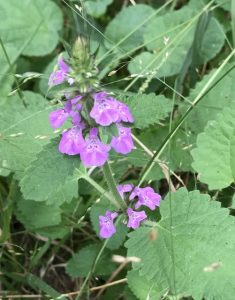
Hachinal Corner specialty garden offered a sensational treat — Brush Holly, Xylosma flexuosa — like most of us who work weekly around Ebony Loop have never seen it! Sure, we see a healthy shrub with pretty green leaves, but this December? Amazing! Loaded with berries running all around its branches.
Even PDST (page 274) comments that they “only occasionally produce the large quantities of fruit” as we are seeing this year. “The fruit are a food source for birds.” The Hachinal Corner garden was designed as a bird sanctuary.
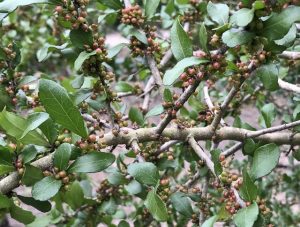
From another view, in the luminescent bright light of an overcast sky, huge thorns make themselves known!

The lantanas along the path — West Indian, Lantana camara, Texas, Lantana urticoides; and Velvet, Lantana velutina, (pages 415-417) are still in full bloom and loaded with butterflies from common maestra, white peacock, sickle-winged skippers, Gulf fritillaries, queens, the big yellows — orange-barred sulphur and more! The air is as colorful as the shrubs!
The odd bug or two showed itself and was sluggish to move away even as the morning warmed up. This one really didn’t mind its photo taken. Later I learned that it is nocturnal, and probably reluctant to move away because it was supposed to be sleeping.
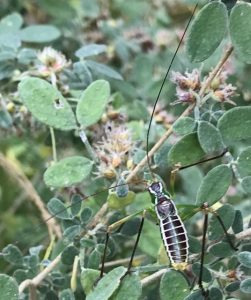
Thanks to our Ebony Loop volunteer team co-chair, Texas Master Naturalist and plant guru extraordinaire Frank Wiseman, for introducing me to the Texas Insects Facebook page.
Page member Joseph Conners ID’d (complete with scientific name) our unusual, segmented critter that we’d found in a dalea scandens (page 261) shrub across from the Betty McEnery Memorial Garden.
The critter’s name is as long as its antennae: chestnut short-winged katydid (Obolopteryx castanea)
Some research sites say katydids and their nymphs are harmful, other sites say they don’t do that much damage. Another site mentioned that katydids eat leaves, buds, stems, flowers – literally from roots to seeds – they also “take bites out of fruit” (citrus) and cause misshapes, but don’t destroy the fruit. They are nocturnal – and – are food up the chain for, “many animals, including birds, bats, rodents, tree frogs, spiders, and praying mantids.”
An interesting Internet page from Master Gardener Program, University of Wisconsin-Extension had some interesting reading on katydids. https://wimastergardener.org/article/katydids/
This was a fun read from The Daily Garden — https://www.thedailygarden.us/garden-word-of-the-day/katydids — Katydids as thermometers:
“If you hear a katydid, you can estimate the ambient temperature using Dolbear’s law. According to Amos Dolbear’s 1897 calculations, you can count the number of cricket chirps that occur over a 15 second period and then add 40 to that number for a reasonable estimate of temperature. If you are using katydids for this experiment, it is suggested that you add 37, instead of 40.” — I have no answer to that three-degree of separation!
Leaving the katydids to do their thing, many of our favorite vines were showing their fall colors. Mexican Urvillea, Urvillea ulmacea, (page 381) with its clumps of football-shaped bronze-colored seed pods, hangs from branches in the distance; closer to the path, golden-brown Common Balloon Vine, Cardiospermum halicacabum, (page 380) seed pods dangle from the shrubs where their vines have woven through the vegetation.

If spring mint is a reminder of spring, coral bean, Erythrina herbacea (page 261) pods and seeds are a definite fall season display.
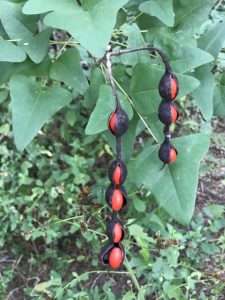
A most spectacular ending to the December First-Friday walk was an up-close look at the rarest tree in Texas, Runyon’s Esenbeckia, Limoncillo, Esenbeckia berlandieri [E. runyonii] (page 376). It’s laden with big, nearly 1 ½-inch diameter, segmented, green seed pods, camouflaged by the tree’s large leaves of the same green hue.

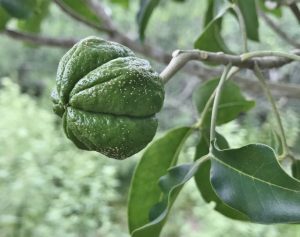
And if that wasn’t a grand enough ending to the two hour tour, an unexpected beacon of yellow flashed from the underbrush on the sunless day begging our attention as we headed to the exit —Trixis, Trixis inula, page 133. For a plant that should bloom in all seasons, those in Ramsey park seem to glow only for special occasions, which makes them a rare treat indeed.
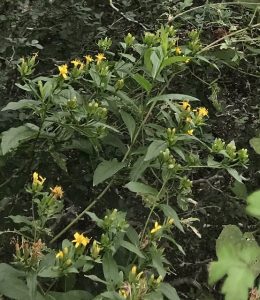
First Friday and Third Saturday guided native plant tours are available through May 2019. The tour highlights the specialty gardens around Ebony Loop. The trail is a level, quarter mile long, caliche path. No reservations necessary, just meet the guides in the parking lot. The two-hour tours begin at 9 a.m.
For Texas Master Naturalists, two hours of advanced training are allowed and for Master Gardeners, two-hours of continuing education.
The guides subscribe to what we consider the bible of native plants in the Rio Grande Valley. It is the Richardson, A., King, K. 2011, Plants of Deep South Texas: A Field Guide to the Woody and Flowering Species. Texas A&M University press, College Station.
We often refer to the author’s comments and show pictures of flowers of significant plants if they are not in bloom during a tour and people are curious. We are often asked how to purchase the book.
The book generally sells for $30 and is available at many of the local nature preserves like Laguna Atascosa, Weslaco’s Valley Nature Center and online at Amazon.com.